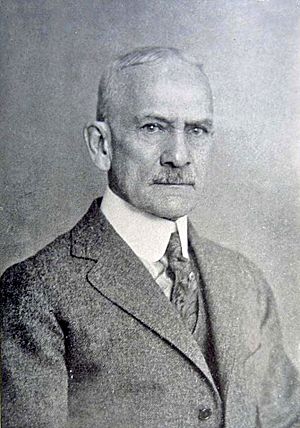Charles Chapin facts for kids
Charles E. Chapin (October 19, 1858 – December 13, 1930) was a New York editor of Joseph Pulitzer’s Evening World. He was convicted of the murder of his wife and sentenced to a 20-year-to-life term in Sing Sing prison.
Contents
Career
Chapin was born in upstate Watertown, New York and began his career on a Kansas newspaper, aged 14, moving later to Chicago to work for the Tribune, where he gained renown as a crime reporter. He excelled sufficiently to be hired in 1898 by the Evening World, a New York daily, run by the Pulitzer family.
Unlike the morning World, which Pulitzer saw as a reflection of his voice and serious-minded sensibilities, the Evening World was "a commercial enterprise" with an emphasis on crime and entertainment. It enjoyed one of the largest circulations in the country, thanks in part to Chapin's news instincts and use of large, "startling" headlines.
Chapin was known as a hard taskmaster. He is said to have fired a total of 108 journalists during his tenure – one of them for daring to use the new-fangled word "questionnaire". Among his victims was his own publisher's son, Joseph Pulitzer Jr., after the younger Pulitzer repeatedly missed work. The elder Pulitzer backed Chapin's decision, and later sent his son to the St. Louis Post-Dispatch, where Joseph Pulitzer Jr. helped turn it into "one of the nation's best, most influential and profitable newspapers."
According to Chapin'e editorial philosophy, "Gathering the news of a great city is a carefully thought-out and systematized piece of human machinery that operates under the personal supervision of the city editor."
He considered himself a newspaper man, not a journalist, and stated, "Journalism! How I grew to detest that much abused word. Every brainless mutt I ever met in a newspaper office described himself as a "journalist.” The real men, the men who knew news, knew how to get it and knew how to write it, preferred to be known as newspaper men. One never hears a star reporter along Park Row speak of journalism."
Chapin relentlessly insisted on finding breaking news and once after J. P. Morgan's security detail battered one of his reporters, Chapin allegedly told him, "You go back and tell Morgan he can’t intimidate me!"
Gaynor photograph
One of Chapin's most celebrated coups was the publication of a photograph captured by an Evening World photographer showing the moment when New York mayor William Jay Gaynor was shot by a would-be assassin.
Death
He died of pneumonia in Sing Sing on December 13, 1930.
Opinions of Chapin
For two decades Chapin was the city editor of Joseph Pulitzer’s Evening World. Many newspapermen considered Chapin to be "the ablest city editor who ever lived". Those who worked for him, however, often hated him. When Irvin S. Cobb, the well-known World reporter, heard that his editor was sick, he is said to have looked up from his work and remarked, "I hope it’s nothing trivial." According to Andy Logan, a noted correspondent to The New Yorker, Chapin was "terrible tempered" and in the opinion of many of his staff had "a legendary imperviousness to human suffering, especially theirs." Pulitzer referred to Chapin as "Pinch" in the code the publisher used to mask his correspondence. It was suggested that by overemphasizing sensationalism Chapin became instrumental in propagating the yellow journalism style of newspaper reporting.



